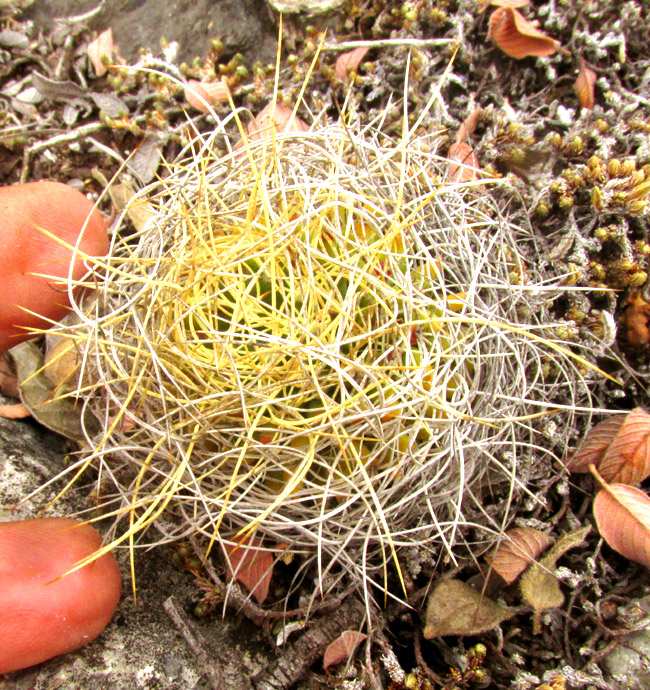Excerpts from Jim Conrad's
Naturalist Newsletter
Entry dated March 9, 2024, from notes taken about 2kms west of Higuerillas, Municipality of Cadereyta de Montes; N20.9086°, W99.7865°, elevation ~1760 meters (~5760 feet); on greywacke sandstone cap of hill; area constituting a narrow belt of the extreme southern extension of the Chihuahuan Desert, Meridional Subregion; central Querétaro state, MÉXICO
BIRD'S-NEST PINCUSHION

The above little cactus sheltered between two greywacke-sandstone rocks emerging from thin soil atop the hill. Its tangle of spines obscured the cactus body's features, but from certain angles and close up, enough details could be seen to figure out who this was:

With the body's surface divided into many mound-like, slender-topped tubercles with no hint of a furrow or groove extending from the spine bases into or toward the bottoms of the tubercles, this just had to be a species of Mammillaria. Mammillarias are variously called pincushions, nipple cactuses or just mammillarias.
Of the 41 or so mammillaria species native to our upland, central Mexico region known as the Bajío, the exceptionally long, curved, densely entangled spines were this species' most obvious distinction, but also there were others: the crusty looking spots, the areoles, from which spines arose atop each tubercle were circular, not elongated; from most areoles only five or so spines arose, and they were all radial, with no erect central spines; arising in the valleys between tubercles were a few slender, weak, curling, hair-like white trichomes, and; the green tubercles' tips tended to become orangish yellow.
These features lead to MAMMILLARIA DECIPIENS, in English often known as the Bird's-nest Pincushion. The species is endemic just to central Mexico, from about Zacatecas state in the north to Jalisco state in the south. It occurs in upland arid scrub and oak forests.
Three subspecies have been described, though the 2019 Flora del Bajío treatment of the genus, by David Aquino, says that in our area the subspecies aren't always clearly distinct, and currently Kew's Plants of the World database lumps all the subspecies into the species name. If the subspecies are accepted, our plant, because it lacks central spines and the radial spines are curvy, is Mammillaria decipiens ssp. camptotricha.
On the Internet, nearly all pictures of this species are of potted plants on which the plant body isn't nearly as concealed by the tangle of spines as on our individual. Probably that's because on cacti receiving regular watering the tubercles expand, moving spine clusters farther apart. Also, most images show plants with little or no yellowness. Currently this area is indicated by the North American Drought Monitor to be experiencing a D3 Extreme Drought, and the drought has been ongoing for over two years. Perhaps if the last rainy season had materialized our cactus body wouldn't be so yellowish, or small.
On the Internet so many pictures are of potted plants because the species is widely marketed for potting, with warnings not to overwater. Also, it should be kept in well drained soil, and provided with plenty of bright sunlight. Of the subspecies, our curvy-spined camptotricha appears to be most favored for sales, maybe because it best lives up to its birdnest name.
Probably because of the limited distribution of Mammillaria decipiens and its similarity to other species, I find no traditional human uses for it. Ana María Álvarez Palma's 2009 study "Uso alimenticio y medicinal de las cactáceas entre los seris de Sonora," indicates that the Seri people of Mexico's arid northwestern state of Sonora used 26 cactus species in various ways.
Two mammillaria species in the area of study were were eaten. Mammillaria microcarpa, somewhat similar to our species but with hooked central spines, was used medicinally for ear aches. The spines were burned off, the plants boiled in water and peeled, and the resulting pulpy vascular network was ground up. The resulting liquid was put in the ears. In one documented case, the cactus's root was boiled in water, resulting in a cure for eye pains. Numerous other uses were reported for other cactus species, often in magical-religious ceremonies.